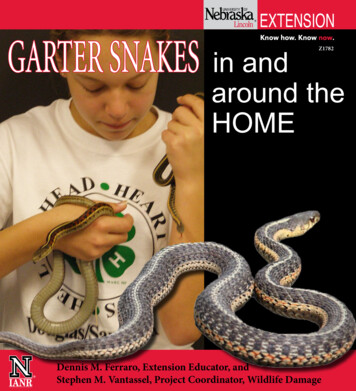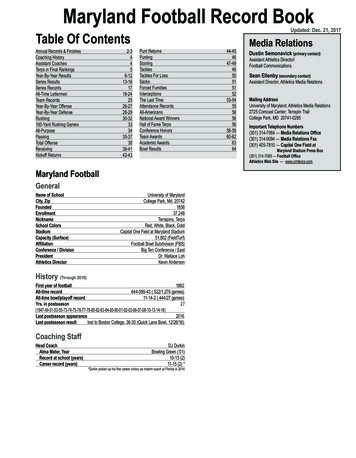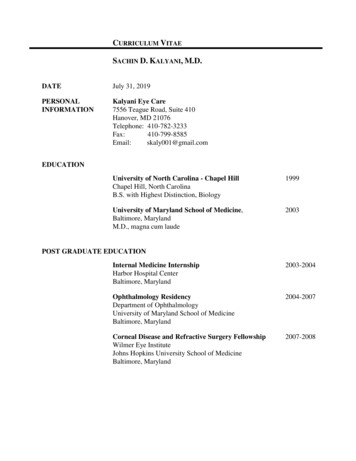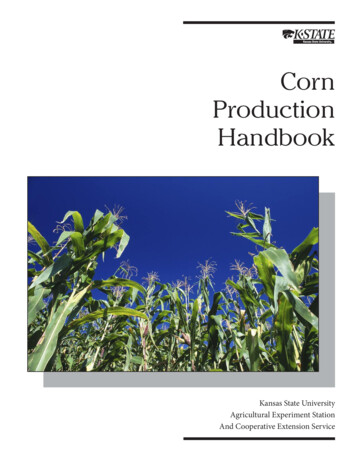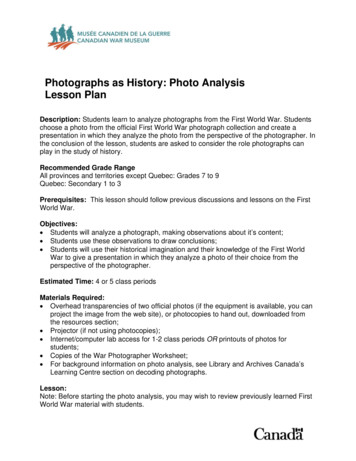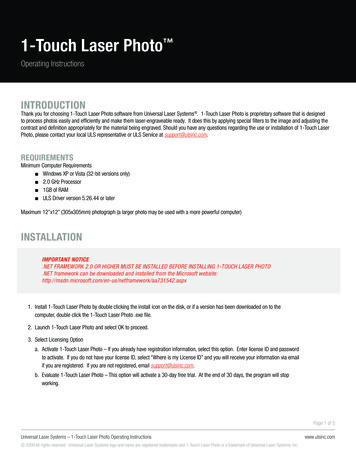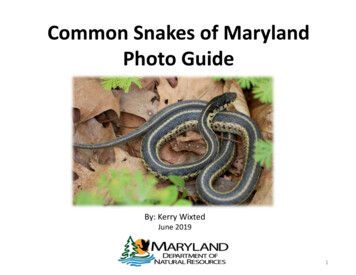
Transcription
Common Snakes of MarylandPhoto GuideBy: Kerry WixtedJune 20191
Table of ContentsThe common snakes in this guide are arranged so that similar looking species are represented close to oneanother. Below is an alphabetized list of the common snakes represented in this guide with page referencesas well as a list of Maryland snakes not found in the guide. For information on snakes not found in this guide,please visit our website: dnr.maryland.gov/wildlife. Maryland Snakes found in the guide:Common Gartersnake pgs 15-16Common Watersnake pgs 7-9, 21Dekay’s Brownsnake pg 18Eastern Copperhead pgs 4, 5, 21Eastern Hog-nosed Snake pg 14Eastern Milksnake pg 20Eastern Ratsnake pgs 10-11, 21Eastern Ribbonsnake pg 17North American Racer pgs 12-13, 21Northern Ring-necked Snake pg 19Southern Ring-necked Snake pg 19Timber Rattlesnake pg 6 Maryland Snakes not found in the guide:Coastal Plain MilksnakeCommon WormsnakeEastern KingsnakeEastern PinesnakeMountain EarthsnakeNorthern Mole KingsnakePlain-bellied WatersnakeQueensnakeRainbow SnakeRed CornsnakeRed-bellied SnakeRough GreensnakeScarlet SnakeSmooth EarthsnakeSmooth GreensnakeAcknowledgements:Thanks to all of the photographers for providing photos for use in this guide. In addition,the following people provided helpful edits: Paula Becker, Lynn Davidson, Nancy Doran,Rachel Gauza-Gronert, Scott McDaniel, Beth Schlimm, Scott Smith and Glenn Therres.2
Snakes of MarylandSnakes are an integral part of Maryland’s fauna, functioning as important predators of mice, rats and otheranimals. Snakes are limbless reptiles with elongate bodies that are covered with scales. Maryland is home to27 species and sub-species of snakes. This guide covers commonly encountered snakes.Two species, the Eastern Copperhead and the Timber Rattlesnake, are pit vipers (Subfamily Crotalinae) andpossess medically significant venom. Pit vipers are named for the heat-seeking pit between each eye andnostril. Both of Maryland’s pit vipers should be treated with caution and should not be approached orhandled. The graphic on the left, and the associated table below, show characteristics of pit vipers inMaryland versus other Maryland snakes. These characters do not work for venomous snakes outside ofMaryland. For more information on snakes, please visit: dnr.maryland.gov/wildlifeOther Maryland Snake IDCharactersPit Viper ID Characters1. Round pupils1. Elliptical pupils2. No sensory pit2. Sensory pit between eyeand nostril3. Head slightly wider thanneck*3. Head much wider thanneck*4. Divided anal plate scale**4. Single anal plate scale**5. Double row of scales on theunderside of tail **5. Single scales onunderside of tail*** Some snake species, like Eastern Ratsnakes, Common Watersnakes, and Common Gartersnakes will flatten theirheads when threatened to mimic pit vipers.** These characteristics are helpful when examining shed snake skins.3
Photo by: Richard H. Legere Jr.Eastern CopperheadVenomous. Found throughout most of Maryland. Has Hershey-kiss shaped markings thatare skinny at the top and wider at the base. Head is coppery in color with a contrastingupper lip.4
Photo by: Andrew Hoffman CC by NC ND 2.0Eastern Copperhead- JuvenileVenomous. Found throughout most of Maryland. Has Hershey kiss shaped markings thatare skinny at the top and wider at the base. Head is coppery in color with a contrastingupper lip. Juveniles have a bright yellow tail used as a lure for prey.5
Photo by: Peter Paplanus CC by 2.0Timber RattlesnakeVenomous. Found in western Maryland. Color variable from light and striped to almostdark black with jagged stripes. Has distinct rattle at end of tail.6
Photo by: Judy Gallagher CC by 2.0Common WatersnakeFound throughout Maryland. Pattern highly variable with variations including bands that arethicker at the top and thinner at the bottom, incomplete bands, or no bands. Has dark lipstripes. Often mistaken for cottonmouth (water moccasin) which does not occur in Maryland.7
Photo by: Jane Kirkland CC by NC ND 2.0Common WatersnakeFound throughout Maryland. Pattern highly variable with variations including bands that arethicker at the top and thinner at the bottom, incomplete bands, or no bands. Has dark lipstripes. Often mistaken for cottonmouth (water moccasin) which does not occur in Maryland.8
Photo by: Andrew DuBois CC by NC 2.0Common Watersnake- JuvenileFound throughout Maryland. Pattern highly variable with variations including bands thatare thicker at the top and thinner at the bottom, incomplete bands, or no bands. Has darklip stripes.9
Photo by: Richard OrrEastern RatsnakeFound throughout Maryland. Uniform black on top or with faint traces of a spottedpattern. Throat and underside light colored. Adept climber.10
Photo by: Robert WarrenEastern Ratsnake- JuvenileFound throughout Maryland. Grayish with dark blotches along back. Has dark bar betweeneyes that continues past the eye to corner of mouth.11
Photo by: Lisa Reid CC by NC ND 2.0North American RacerFound throughout Maryland. Sleek in appearance. Plain black above and steely gray toblack below. Often white coloration seen on the chin. Large prominent eye.12
Photo by: Bill Hubick, Maryland Biodiversity ProjectNorth American Racer- JuvenileFound throughout Maryland. Strongly patterned, like watersnakes and ratsnakes, but havemore blotches down the back, a set of blotches along the centerline and proportionally13larger eyes, an adaptation for open field hunting.
Photo by: Andrew Hoffman CC by NC ND 2.0Eastern Hog-nosed SnakeFound throughout Maryland. Coloration is variable with yellow, brown, gray, orange or redon a dark splotch-patterned back. However, some individuals are an un-patterned ebonyblack or dark grey. Snout upturned. Often will flatten out head, hiss, pretend to strike,14and/or play dead if disturbed.
Photo by: Kerry WixtedCommon GartersnakeFound throughout Maryland. Back is greenish, olive, brown or black with a yellow or whitestripe down the centerline. May have a white to yellow stripe on either side of the centerlinestripe and the area between is often a checkerboard pattern of blackish and green spots. 15
Photo by: Andrew Hoffman CC by NC ND 2.0Common GartersnakeFound throughout Maryland. Back is greenish, olive, brown or black with a yellow or whitestripe down the centerline. May have a white to yellow stripe on either side of the centerline16stripe and the area between is often a checkerboard pattern of blackish and green spots.
Photo by: Kevin Enge CC by NC ND 2.0Eastern RibbonsnakeFound throughout most of Maryland. Very slim snake with a distinctively narrow delicateneck, brown-capped head and very long tail. Three bright yellow or cream stripes run thelength of the brown to nearly black body. Has light-colored spot in front of eye.17
Photo by: Mark Nenadov CC by 2.0Dekay’s BrownsnakeFound throughout Maryland. Small, brownish/gray snake with small, paired black spotsrunning down the back. A thin dark line extends from the back of the head behind the eye18to the base of the jaw. Juveniles have a light band across their neck.
Ring-necked SnakesPhoto by: Matt ClosePhoto by: Linh PhuFound throughout Maryland. Twosubspecies occur in the state:Northern Ring-necked SnakeBack is a uniform dark gray, bluishblack or brown. Has cream-to-yellow ororange neck collar and yellow belly,which may grade to red towards thetail. Has complete neck ring and bellyhas no or small black spots down themidline.Southern Ring-necked SnakeBack is a uniform dark gray, bluishblack or brown. Has cream-to-yellow ororange neck collar and yellow belly,which may grade to red towards thetail. Has broken or notched neck ringbehind head and belly has large, blackhalf-moon shaped spots down themidline.19
Photo by: Peter Verdonk CC by NC 2.0Eastern MilksnakeFound throughout western and central Maryland. Slender snake colored tan to light brownwith 32 or more blotches (broad red with black-borders) down the body in three or five20rows. At the nape of the neck, there is a grey or tan Y-, V-, U, or A- shaped patch.
Photo by: Andrew DuBois CC by NC 2.0Photo by: Robert WarrenNorthern CopperheadEastern RatsnakeCommon WatersnakePhoto by: Bill Hubick, Maryland Biodiversity ProjectPhoto by: Andrew Hoffman CC by NC ND 2.0Juvenile Snake ComparisonsNorth American Racer21
For Additional InformationFor more information on Maryland’s snakes, please visit our webpage at: dnr.maryland.gov/wildlifeAdditional information can be found in the following resources.Book Resources: The Maryland Amphibian and Reptile Atlas Peterson Field Guide to Reptiles and Amphibians of Eastern andCentral North America, 4th EdOnline Resources: A Key to Reptiles and Amphibians of Maryland (PDF) Captive Reptile and Amphibian Permits and Licenses (MD) Maryland Biodiversity Project Virginia Herpetological Society- Snake ID GuideLarry Hogan, Governor Jeannie Haddaway-Riccio, SecretaryWildlife and Heritage Service * 580 Taylor Ave, E-1* Annapolis, MD 21401410-260-8540dnr.maryland.gov/wildlife22
Book Resources: The Maryland Amphibian and Reptile Atlas Peterson Field Guide to Reptiles and Amphibians of Eastern and Central North America, 4th Ed Online Resources: A Key to Reptiles and Amphibians of Maryland (PDF) Captive Reptile and Amphibian Permits and Licenses (MD) Maryland Biodiversity Project
